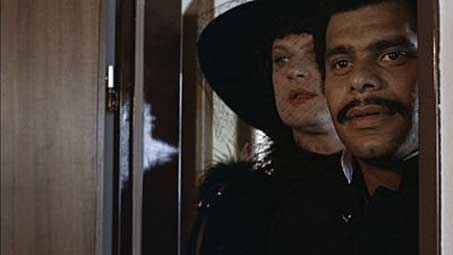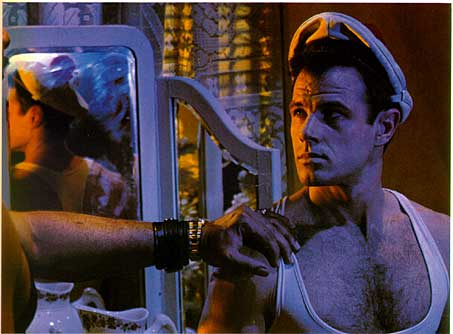
 |
||||||
|
GAY
FILM REVIEWS BY MICHAEL D. KLEMM
|
||||||
|
Fox
And His Friends 1975 Director:: Screenplay: Starring: Rainer Werner Fassbinder, Peter Chatel, Karlheinz Bšhm, Adrian Hoven, Christiane Maybach, Harry Baer, Hans Zander, Kurt Raab Unrated, 123 minutes
In
A Year Of 13 Moons Director/Screenplay: Starring: Volker Spengler, Ingrid Caven, Gottfried John, Saitz Elisabeth Trissenaar, Eva Mattes, GŸnther Kaufmann, Lilo Pempeit, Isolde Barth, Karl Scheydt Unrated, 124 minutes
Querelle Director:: Screenplay: Starring: Brad Davis, Franco Nero, Jeanne Moreau, Laurent Malet, Hanno Pšschl, GŸnther Kaufmann, Burkhard Driest, Roger Fritz, Dieter Schidor Unrated, 108 minutes
|
Cinema
of the Absurd
The late Rainer Werner Fassbinder, along with Werner Herzog and Volker Schlondorff, re-defined German cinema in the 1970s. Fassbinder directed 43 features between 1965 and 1982, including Berlin Alexanderplatz, a 16 hour miniseries for German television, and these films range from brilliant to awful.He surrounded himself with a circle of bohemian artists and actors, not unlike Andy Warhol's Factory during the 1960s. Though twice married, he was also openly gay. Fassbinder was a tortured soul who directed film after film to escape his own loneliness. By turns generous and abusive, he reportedly drove two male lovers to suicide while he slid into an abyss of extravagant drug use. He was only 36 when he died of a drug overdose (some say suicide) in 1982.
Fox and His Friends (Faustrecht der Freiheit), 1975, chronicles the sad tale of Fox, played by Fassbinder himself, a homely gay man who suddenly finds himself the toast of high society when he wins $500,000 in a lottery. Fox is a member of a circus side show that is shut down by the police. A chance encounter in a public lavatory with Max, a wealthy antique dealer, leads to a new life. Max's snobby friends sneer at this young man in desperate need of a bath but, when Fox wins the lottery, they become greedy vultures who welcome him into their circle with open arms.
Fox and His Friends is really about class and the homosexuality of the leads is almost incidental. This is rare for films from the 1970s, even European ones. Rather than explore coming out issues, Fassbinder instead spins the tale of a poor lower class slob who is abused by rich upper class snobs. What begins as a comedy of manners shifts into a study in humiliation as Eugen continually embarrasses Fox in public by correcting his conduct and belittling his tastes. Later, when the money is almost gone, Eugene coldly announces "We must stop making love every day. We're not starry-eyed lovers any more."
|
 |
|
|
In A Year Of 13 Moons (In Einem Jahr Mit 13 Moden), 1978, is a variation on a similar theme. Volker Spengler is Elvira, a lonely transsexual once known to his acquaintances as Erwin before his journey to Casablanca for a botched operation. [Note 2009: I wonder if director John Cameron Mitchell saw this film when he grew up in Germany and it helped inspire Hedwig and the Angry Inch.] As Erwin, he had a wife and a daughter before falling in love with a wealthy industrialist who dumped him shortly after his sex change. Elvira then entered an abusive relationship with a actor named Christoph.
Elvira may be one of the pathetic characters ever to flicker on the silver screen. Unfortunately, Fassbinder muddies the story with political statements, and keeps the audience at a distance from Elvira by continually offering long monologues instead of dramatizing the scenes she describes. 13 Moons was written, shot and edited by Fassbinder himself following the suicide of one of his lovers, and the personal nature of the film is immediately apparent. But there is often a fine line between personal statement and self indulgence.
13 Moons begins splendidly and then lapses into what may initally appear to be nonsense if you aren't up on 1970s German politics. This is a shame because Spengler's performance as Elvira is remarkable. The film would have been much better had it dramatized more of the events in his/her life instead. Reviewer's note 2008: I recently re-visited 13 Moons; it was during a Fassbinder binge when I discovered now many of his letterboxed DVDs were available at Netflix. I get these strange urges now and then but now I've seen, for the first time, The Bitter Tears Of Petra Van Kant, Beware Of A Holy Whore and Whity, and revisited The Marriage of Maria Braun and Veronika Voss. Anyway, I thought I'd re-visit In a Year Of 13 Moons. I came to it, now, armed with more knowledge about the suicide of his lover Armin Meier, which certainly explains the pallor of death that blankets the film. Knowing now, too, that Fassbinder was influenced by Bertolt Brecht explains the deliberate use of detachment as a dramatic device. At times, this approach works - sometimes too well. That scene in the slaughterhouse made me wish I had listened to my parents in high school and learned their native German because I could have shut my eyes; instead I had to read the subtitles and it was a bit like Alex in A Clockwork Orange, with his eyes clamped open, being forced to watch this carnage on the screen. Fassbinder often demands much from his audience and 13 Moons is a primal scream. Not everyone wants to be subjected to this much pain. This is a remarkable film, but I still wouldn't recommend it for the casual viewer who doesn't feel like a brain workout that night. A cousin from Germany was here for a visit a few years ago and, when I casually mentioned Fassbinder, she made such an odd face. What I didn't realise was that Fassbinder was a household word in Germany and that all the lurid details of his wild personal life were plastered all over the tabloids in the 1970s. There was drugs, parties, gay sex, two marriages, and two suicides. You could say that his outrageous exploits were as well known in his native country as Paris Hilton's are in America. And to think, back in the carefree 70s, we just thought that Fassbinder was just this acclaimed international filmmaker but more people in Germany knew about his scandals than about his films. When I first saw The Marriage of Maria Braun, back in 1978 or 1979, it came without any overseas baggage. I didn't even know that Fassbinder was queer yet.
|
|
 |
|
|
While Fox and 13 Moons' gay and transgendered protagonists are victims, Querelle's is a destroyer. Fassbinder's final film is an adaptation of the 1949 homoerotic sailor-port novel by Jean Genet, Querelle de Brest.
Critical opinions on the film differed. Andy Warhol told Fassbinder that it made him hard and The Advocate called it a "pretentious bore." I, myself, have seen it several times over the last decade and I still don't know what to make of it. Yet Querelle's images have haunted me for most of my adult life. Love it or hate it, no viewer will ever forget it.
Reviewer's note 2007: When I reviewed Querelle 7 years ago, I had only seen the film on a pan-and-scan VHS tape. A few years ago, the film was released in its full cinemascope wide screen on DVD. Let me tell you, seeing the film for the first time in its original screen ratio was a revelation (basically I was missing half of the image when I'd seen it before). It was like I was seeing a different film. I had always considered Querelle to be very clumsily filmed but now I know that is not the case at all. It looked that way because I was only seeing half of Fassbinder's compositions. Besides losing the artistry, many shots do not even make any sense unless you see the film in widescreen. I mean this as the greatest compliment to the late Mr. Fassbinder when I say that Querelle is up there with Kubrick's 2001: A Space Odyssey - it is one of these films that are destroyed when not seen in their entire widescreen glory. You can't tell that I'm a stickler for letterboxing films now, can you? Lawrence of Arabia or West Side Story or Apocalypse Now or Blade Runner in pan and scan? Please...
More On Jean Genet:
|
|
|
|